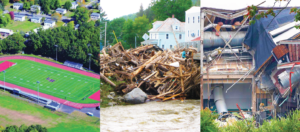
In the past decade (from left to right), Lyman Hall reconstructed its track; Wallingford endured Hurricane Irene; and the Bristol-Myers Squibb building was demolished. Photos courtesy of BSC Group, Wallingford Real Estate, and Record Journal.
Over the past decade, citizens of Wallingford have seen major changes within the town. Food and living preferences have evolved; new establishments have been added; and several public facilities have been improved. Aside from major improvements, buildings have also been reconstructed and renovated due to severe weather. More so than its surrounding towns, Wallingford has undergone an eventful past ten years.
Preferences
Throughout this past decade, the demand for residential property has risen dramatically, while the number of commercial office spaces has dropped. According to Jon Walworth, architect and former member of Wallingford’s Parks & Recreation Commision, “Office spaces located in small towns are no longer appealing to citizens. Smaller towns, like Wallingford, are adapting gradually towards residential in place of commercial office space.” To capitalize on the increased demand, Wallingford has implemented a zoning regulation called Incentive Housing Zone (IHZ), which increases the amount of area available for residential units. This regulation led to the construction of a new apartment complex near the Wallingford train station.
Aside from a greater demand for residential units, Wallingford has also seen large changes in its food scene. Over the past decade, several pizza restaurants have closed. Today, twelve remain in Wallingford. Meanwhile, Asian cuisine has grown in popularity as new Asian restaurants, such as Funju Noodle Bar, Za-Onn Thai House, Panda Garden, and Hot Pot, have spread through the Wallingford-Yalesville area. “I am a landlord in town and have experienced, first-hand, the weakening pizza market in Wallingford. I had a pizza restaurant and an Asian restaurant open in my plaza. The pizza place, formerly known as Jimmy’s Pizza was not successful. On the other hand, the Asian restaurant is still open and doing well to this day,” said a local landlord who asked to remain anonymous.
Construction
Wallingford citizens have also witnessed a series of public facility renovations and the construction of new establishments in town. The first major construction project this past decade was the reconstruction of the Lyman Hall track. The Wallingford Board of Education began planning for this addition in 2013 and completed the process in 2015. “The new track was definitely a major school improvement. After our track and football field was completed, it caused more kids to play sports for Lyman Hall. It really makes kids take pride in putting on an LH jersey or uniform,” said Aidan Weir, a junior at Lyman Hall High School. The school now hosts track and field meets as well as football games on the new track area.
This project was only one part of the town’s efforts to improve public facilities over the past decade. In 2017, the engineering department completed its largest project of the decade: a new train station that connects Wallingford to stations from New Haven to Springfield, Mass. The station not only facilitates transportation for commuting residents but also attracts new residents to Wallingford. “The railroad station was really a dramatic change in downtown Wallingford. The final product was also a very nice design, like something we would see in Europe, perhaps,” said Mr. Walworth.
The community pool, one of the most popular attractions in Wallingford, is also currently being renovated.. The committee planning the pool’s renovation aims to transform the community pool into a more attractive, modern, and sanitary facility. “As of now, the committee is planning to run a $6-million renovation with potentially some public bids coming in the spring,” said Mayor William Dickinson. Included in the planned renovations is a splash pad with different water games for younger visitors. “The community pool is really a marvelous aquatic facility that adds a lot to the town,” said Mr. Walworth.
Weather
From Hurricane Irene in 2011 to the recent tornado in 2018, Wallingford has had its fair share of weather crises this past decade. Fortunately, according to Mayor Dickinson, the town budget has been designed to reserve funds for these emergencies so that they may be assessed and addressed in a timely manner. However, these disasters have still led to much inconvenience for town residents.
In 2011, Hurricane Irene caused a mandatory evacuation in Wallingford, and all public transportation was suspended. According to Wallingford Politico, damages from this storm cost Wallingford around $900,000. Wallingford also experienced two major snowstorms in 2011, one in January and one in October, both of which left many neighborhoods without power. Later, in February 2013, another snowstorm led to 40 inches of snow and a four-day closure of schools and transportation systems.
More recently, a tornado swept through Wallingford on May 15, 2018. Choate students were held in shelter-in-place as trees and poles outside were brought to the ground by high-speed winds. Sleeping Giant State Park in neighboring Hamden was closed for over a year following the tornado before reopening this past June.
Economy
At the start of the decade, Wallingford was struggling to recover from the 2008 recession, with many businesses on the brink of closing. As the decade progressed, economic conditions improved, and, according to Mayor Dickinson, the unemployment rate in Wallingford fell to 4.5%.
In recent years, the departure of several large businesses has impacted the Wallingford economy. In 2018, the relocation of Bristol-Myers Squibb and Edible Arrangements has led to the loss of more than 1,000 jobs and a significant decrease in tax revenue. These changes have led to minor adjustments in the town budget. However, Wallingford has retained its economic stability with the support of other large companies, including BYK Additives and Instruments and the Amphenol Corporation.
Due to the loss of these larger businesses, the Wallingford Economic Development Commission has renewed its interest in supporting small businesses in town. In 2018 alone, Wallingford welcomed 116 new businesses. Many of the restaurants frequented by Choate students have opened this past decade, including Mr. D’s and J Christian’s, which both opened in 2010, and the Library Wine Bar and Bistro and Pure Alchemy Juice Bar Café, which opened in 2015.
Technology
Accompanying this decade’s technological boom, the Wallingford community has adapted to the changing modern world. In 2016, the Wallingford Public Library underwent a $460,000 renovation project to create the “Collaboratory,” a makerspace that features modern technology such as a laser cutter, long arm quilting machine, and 55-inch Microsoft Surface Hub touchscreen monitor. In the past five years, the library has also added a variety of online resources from movie and TV show access to a Minecraft server for younger visitors.
Using Doordash and Uber Eats, apps launched in 2013 and 2014 respectively, local business have reached more customers around Wallingford. Many local residents have also become part-time or full-time Uber drivers. Furthermore, the town recently became aware that Wallingford Public Schools lacked opportunities to explore STEM-related fields, so new initiatives have been launched to support the growth of STEM programs such as the Wallingford Robotics Club and the STEM Academy, which aims to give students interested in STEM the opportunity to deepen their knowledge outside of the regular school curriculum.




